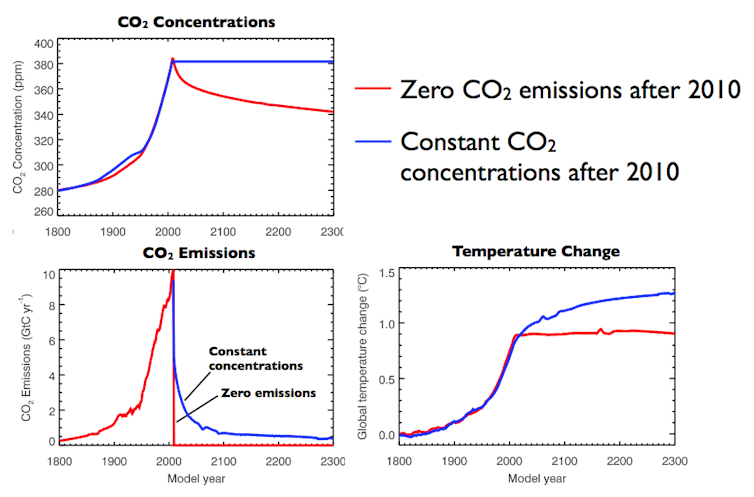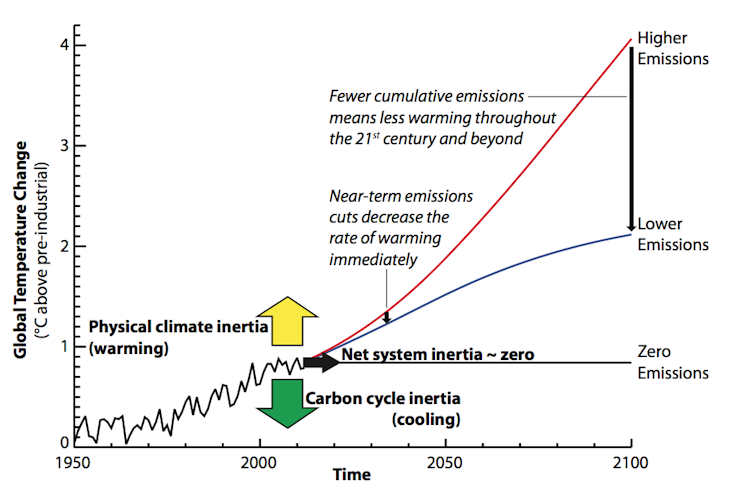There is a commonly held belief among both scientists and the general public that there is a delay between the CO2 emissions we put into the atmosphere, and the resulting climate change. As a consequence, there is a perception that current and near-future climate warming is predetermined by past CO2 emissions, and by extension, that CO2 emissions reductions implemented now will not have any effect on the future rate of global warming for at least several decades.
In a Science Perspective that I have published with Susan Solomon, we argue that this conclusion is based on an incomplete interpretation of the inertia of the climate system. When we consider both the climate and carbon cycle response to emissions, we conclude that CO2 emissions cuts would not be delayed by lags in the climate system.
Rather, if we were successful at decreasing CO2 emissions now, this would result in an immediate decrease in the rate of CO2-induced global warming. Climate mitigation efforts implemented today would be immediately important for the rate at which global temperatures continue to increase.
This has important implications for climate policy. It opens up the possibility that the climate benefits of emissions reductions would occur on the same timescale as the political decisions themselves.
The fallacy of ‘committed warming’
Where did this misunderstanding come from? Why do we seem to think that future climate warming is already pre-determined by past CO2 emissions? Fundamentally, I think this is a confusion of the difference between CO2 emissions and CO2 concentrations in the atmosphere, and in particular of the role of the carbon cycle in determining how much of the emissions we produce actually accumulate in the atmosphere over time.
In 2007 the IPCC report popularised the concept of committed warming: that if we freeze the concentration of greenhouse gases and aerosols in the atmosphere, temperatures will continue to warm by on the order of half a degree this century.
This is the idea of “unrealised warming” or “warming in the pipeline”, which reflects of the amount of time that it takes to warm the ocean. That is, if we increase the strength of the greenhouse effect (by increasing CO2 in the atmosphere), it takes a long time for the earth’s climate system to warm to an eventual new equilibrium (just like a pot of water on the stove, which takes time to come to a boil). This is the so-called thermal or physical climate inertia.
However, stabilising concentrations of CO2 in the atmosphere is not the same as eliminating human CO2 emissions (see Figure 1). Because of the presence of vegetation and ocean carbon sinks (which are currently removing about half of the CO2 we emit), stable CO2 in the atmosphere is consistent with some amount of ongoing human CO2 emissions – albeit only at a level equal to the effect of carbon sinks.

However, added up over time, these future emissions that are consistent with stable CO2 concentrations are sizeable. So, in a scenario of stable CO2 concentrations, we are actually continuing to emit a fair amount of CO2, which is therefore continuing to drive up global temperatures.
Can carbon sinks step in?
By contrast, if we were to (magically) stop emitting CO2 altogether, this would result in declining atmospheric CO2 over time as our past emissions continue to be taken up by carbon sinks. This represents a delayed carbon cycle response to emissions, and means that a there is an additional lag between emissions and the “equilibrium” CO2 concentration that is consistent with those emissions.
This carbon cycle inertia works in the opposite direction to the physical climate inertia described above. As a result, global temperatures do not continue to increase if we stop emitting CO2.
Because of the opposing effects of physical climate and carbon cycle inertia, the future climate warming that is committed to occur due to past CO2 emissions is negligible. There is no “unrealised warming” from past emissions.
While eliminating all CO2 emissions is obviously an extreme (and unrealistic) scenario, the same argument holds for incremental decreases in CO2 emissions. If we emit less CO2, the combined effects of carbon cycle and physical inertia means that we will see less climate change right away – that is, an immediate decrease in the rate of global warming (see Figure 2).

The quicker we stop emitting, the quicker warming will stop
So, the key to slowing the rate of climate warming tomorrow, is to decrease our emissions today. Of course, this is not an easy thing to do. We have an enormous technological infrastructure in place that we rely on to provide energy. Transforming this energy infrastructure to carbon-free technologies will take time, and will result in some amount of unavoidable future CO2 emissions.
It is this technological inertia, combined with political and human behavioural inertia, that constrains our ability to enact mitigation efforts quickly to affect near-future temperature changes. As a result, most of the scenarios of future emissions, which diverge widely by the end of the century, are actually very similar over the next few decades.
But “similar” does not mean “the same”. Global warming is incremental – every increment of CO2 emitted corresponds to an immediate increment of warming. Every CO2 emission avoided now means incrementally less climate warming, not in several decades, but now. Successful climate mitigation has the power to decrease warming on the same timescale as the emissions reductions themselves.
And I do see this as reason for hope. The idea that some amount of future global warming is impossible to avoid is not a very hopeful message, and makes it difficult to motivate action on emissions reductions. However, future warming is not “impossible” to avoid – just very difficult. Fundamentally, the future course of global warming is still within the scope of human control.

